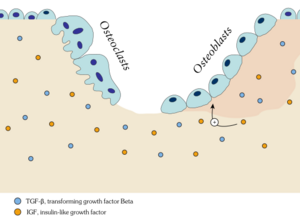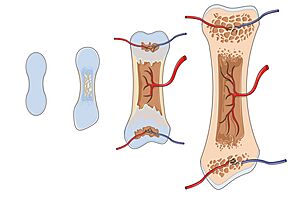Ossification facts for kids
Ossification (say: oss-ih-fih-KAY-shun) is the amazing process where your body creates new bone. It's also called osteogenesis (say: oss-tee-oh-JEN-uh-sis) or bone mineralization. This happens thanks to tiny cells called osteoblasts. Think of osteoblasts as the builders of your bones!
There are two main ways your body forms healthy bone:
- Intramembranous ossification is when bone forms directly from a type of early body tissue called mesenchyme. This is how flat bones, like those in your skull, are made.
- Endochondral ossification is when bone first starts as cartilage, and then that cartilage slowly turns into bone. This is how most of your long bones, like those in your arms and legs, grow.
When you break a bone, your body uses a similar process to heal it. Often, endochondral ossification helps mend long bone fractures. If a doctor uses metal plates or screws to fix a break, intramembranous ossification might be more involved.
Sometimes, bone can form in unusual places outside your skeleton. This is called heterotopic ossification. Don't confuse ossification with calcification! Calcification is just when calcium salts build up in cells or tissues. It's a part of ossification, but not every time calcium builds up does it mean bone is forming.
Scientists are still learning exactly how bone development starts. But they know that special signals, like growth factors, play a big role.
| Time in Development | Bones Affected |
|---|---|
| Third month of a baby's development | Long bones start to form |
| Fourth month | Most main bone-forming centers appear in the middle part of bones |
| Birth to 5 years | New bone-forming centers appear at the ends of bones |
| 5 to 12 years (girls), 5 to 14 years (boys) | Bone formation spreads quickly, and many bones become solid |
| 17 to 20 years | Bones of the upper arms, forearms, and shoulder blades become fully formed |
| 18 to 23 years | Bones of the legs, feet, and hips become fully formed |
| 23 to 26 years | Bones of the chest bone, clavicles (collarbones), and vertebrae (spine) become fully formed |
| By 25 years | Almost all bones in your body are completely formed |
Contents
How Flat Bones Form: Intramembranous Ossification
This is the process that creates the flat bones of your skull, your lower jaw (mandible), and your hip bone.
Here's how it works:
- First, bone-building cells called osteoblasts gather together. They form a "bone-making center."
- Then, these osteoblasts start making a soft, unhardened material called osteoid. This material is good at grabbing onto calcium.
- As calcium attaches to the osteoid, it gets hard. The osteoblasts get trapped inside this new hard material and change into mature bone cells called osteocytes.
- More osteoid is made around blood vessels, forming spongy bone. These blood vessels will later become the red bone marrow inside your bones.
- On the outside, other cells form a protective layer called the periosteum. Osteoblasts in this layer keep adding new bone, creating the strong, compact outer layer of your bones.
How Long Bones Form: Endochondral Ossification
Endochondral ossification is how your long bones (like those in your arms and legs) and many other bones are made. This process starts with a model made of hyaline cartilage. There are two main places where bone formation begins in this process.
The Primary Bone-Making Center
In long bones, the first bone tissue appears in the middle part, called the diaphysis.
- Cartilage cells multiply and form a network.
- Slowly, this cartilage is worn away and replaced by hard bone. This process spreads towards the ends of the bone, called the epiphysis.
- A layer around the cartilage, called the perichondrium, turns into the periosteum. This periosteum creates new bone-forming cells. These cells then make a collar of bone around the outside and help shape the hollow space inside the bone.
- A main blood vessel, called the nutrient artery, enters the bone through a small opening. It brings in bone-forming cells (osteoblasts) and bone-removing cells (osteoclasts).
The Secondary Bone-Making Centers
Secondary bone-making centers usually show up at the ends of the bone, in the epiphysis.
- Most secondary centers appear after a baby is born. (Only a few, like in the thigh bone and shin bone, appear before birth).
- Blood vessels and bone-forming cells enter the epiphysis.
- Bone-removing cells (osteoclasts) break down cartilage, and bone-building cells (osteoblasts) create new bone.
- This happens at both ends of long bones, but only at one end of fingers, toes, and ribs. The area where this growth happens is called the epiphyseal plate or growth plate. This is where bones get longer!
How Bone Changed Over Time: Evolution
Scientists have different ideas about how bone first appeared in animals. One idea is that bone developed from tissues that were used to store important minerals, like calcium. So, bone might have started as a way to store calcium in cartilage, and then it became useful for support and protection. Other ideas suggest bone might have evolved as a protective shield or a way to control water balance in the body.
See also
- Dystrophic calcification, a type of calcium buildup.
- Mechanostat, a model that helps explain how bones grow and lose bone.
- Ossicone, the horn-like bumps on the heads of giraffes.
- Osteogenesis imperfecta, a genetic disease that makes bones very fragile.
- Fibrodysplasia ossificans progressiva, a very rare genetic disease where soft tissues like muscles turn into bone when damaged.
- Primrose syndrome, a rare genetic disease where cartilage turns into bone.





